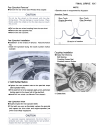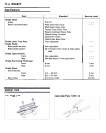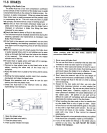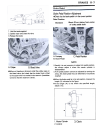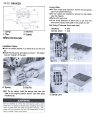
11 -6 B RAKES
When working with the disc brake, observe the
precautions listed below.
Bleeding the Brake Line
The brake fluid has a very low compression coefficient
so that almost all the movement of the brake lever or pedal
is transmitted directly to the caliper for braking action. Air,
however, is easily compressed. When air enters the brake
lines, brake Jever or pedal movement will be partially used
in compressing the air. This will make the lever or pedal
feel spongly, and there will be a loss in braking power.
.Bleed the air from the brake whenever brake lever or
pedal action feels soft or spongy, after the brake fluid is
changed, or whenever a brake line fitting has been
loosened for any reason.
.Check that there is plenty of fluid in the reservoir.
0 The fluid level must be checked several times during the
bleeding operation and replenished as necessary (see
Brake Fluid Change).
*If the fluid in the reservoir runs completely out any time
during bleeding, the bleeding operation must be done
over again from the beginning since air will have entered
the line.
.With the reservoir cap off, slowly pump the brake lever
or pedal several times until no air bubbles can be seen
rising up through the fluid from the holes at the bottom
of the reservoir. This bleeds the air from the master
cylinder end of the line.
*If brake lever or pedal action still feels soft or spongy,
bleed the remaining air as follows.
O Connect a clear plastic hose to the bleed valve at the
caliper, running the other end of the hose into a
container.
O Pump the brake lever or pedal a few times until it comes
hard.
O Holding the brake applied, quickly open (turn counter-
clockwise) and close the bleed valve.
O Repeat this operation until no more air can be seen
coming out into the plastic hose.
0 Check the fluid level in the reservoir every so often,
replenishing it as necessary.
1. Never reuse old brake fluid.
2. Do not use fluid from a containti!r that has been left
unsealed or that has been open for a long time.
3. Do not mix two types and brands of fluid for use in
the brake. This lowers the brake fluid boiling point
and could cause the brake to be in effective. It may
also cause the rubber brake parts to deteriorate.
4. Don't leave the reservoir cap off for any length of
time to avoid moisture contamination of the fluid.
5. Don't change the fluid in the rain or when a strong
wind is blowing.
6. Except for the disc pads and disc, use only disc
brake fluid, isopropyl alcohol, or ethyl alcohol for
cleaning brake parts. Do not use any other fluid for
cleaning these parts. Gasoline, engine oil, or any
other petroleum distillate will cause deterioration of
the rubber parts. Oil spilled on any part will be
difficult to wash off completely and will eventually
deteriorate the rubber used in the disc brake.
7. When handling the disc pads or disc, be careful that
no disc brake fluid or any oil gets on them. Clean
off any fluid or oil that inadvertently gets on the pads
or disc with a high-flash point solvent. Do not use
one which will leave an oily residue. Replace the
pads with new ones if they cannot be cleaned
satisfactori Iy .
8. Brake fluid quickly ruins painted surfaces; any spilled
fluid should be completely wiped up immediately.
9. If any of the brake line fittings or the bleed valve is
opened at any time, the AIR MUST BE BlED
FROM THE BRAKE.
1. Open the bleed valve.
2. Apply the brake and hold it.
3. Close the bleed valve.
4. Then quickly release the brake.





